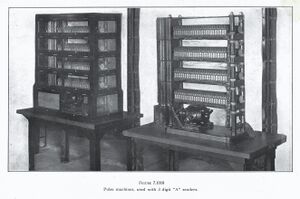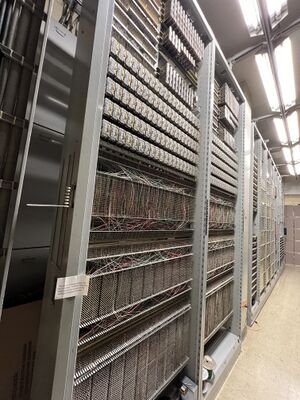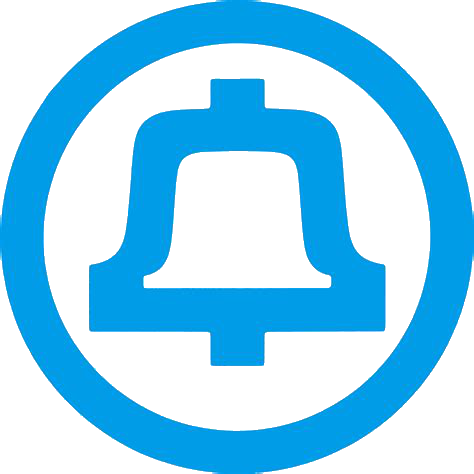Translator
In the art of telephone switching, a translator is a device that converts one type of numerical information into a different type. Although this has parallels to the general concept of translation, as used for example, in translating human languages, translation in telephone switching has had its own unique evolution and application.
Telephone switches use translators for a variety of specific purposes, but all involve converting information from one form into another. This is because the form in which information enters a switching system is not necessarily the best for determining a routing pattern for a call.
Origins

One of the first patents for a system of translation was granted to E.C. Molina in US1083456A. Molina conceived of a mechanical system that could convert from a telephone number into an arbitrary set of addressing information used to drive electromechanical switching mechanisms to their target location. This general concept would go on to become the backbone of the panel switch, where translation was used on each and every call to drive the district and office selectors to the location of the desired outgoing trunk. In the earliest translating systems, after receiving at least three digits from the customer's dial, panel senders directed a special set of panel selectors up over a translator frame. These selectors made contact (over 6 wires) with an arbitrary set of terminals, which was connected to a pulse machine. The pulse machine contained a set of rotating drums with alternating segments of battery and ground on each drum. Depending on the particular connections made back on the translator frame, the set of inputs and outputs to/from the pulse machine caused a particular set of translation relays to be operated in the sender. Based on the setting of these relays, the sender's behavior was configured correctly for that call.
These earliest translators were power-driven, thus prone to error and to mechanical wear. In the mid 1920s, Bell Labs began working on a new type of translator using only relays, called a decoder. Because of their ability to return results quickly, to check for errors on each and every call, and their lack of power driven equipment, decoders became the standard for all new panel offices, and replaced mechanical translation in all almost all panel offices by 1960. Decoders also acted quickly, only taking 300 milliseconds per call on average. This meant that only 3-6 of them were needed per office to handle all of the originating traffic that could be offered to them.
In Crossbar Offices

As crossbar offices became more common, translators did also. The very nature of the crossbar network means that destinations for calls (like telephone numbers or trunk assignments) can not, and should not be arranged in a linear fashion on the network itself. This means that some element of translation is required on every call, since there is no fixed relationship between a called number and its physical location on the network.
Many of these translators contained fields of punchings or terminals that wires would be connected to. The connections between specific terminals are the data contained in the translator. The associated relays are used to extract the required data based on a specific input, in an on-demand basis.
In the 1XB, translation is used in both the originating markers and terminating markers. The originating marker translates a 3-digit office code into set of routing instructions that it then acts upon. Terminating markers translate 4- or 5-digit station numbers into line locations that calls will be connected to. Both of these markers make use of cross-connect fields like the type mentioned above.
Crossbar offices used several types of translators for different purposes, some of which are listed below.
List of Translators
| Type of Translator | Type of Office | Translate from | Translate to |
|---|---|---|---|
| Pretranslator | 5XB | First 3 digits | Instructions for how many digits the OR receives before calling in a marker |
| Local Translator | 5XB | 1, 2, 3 digit office code in local area, or 3 digit foreign area codes | Routing choice for a call, and the route relay to be operated |
| Extended Translator | 5XB | First one or two digits received on incoming calls | Which theoretical office to direct the call to |
| Foreign Area Translator | 5XB | Area codes | Routing instructions for offices in a nearby foreign area. |
| Number Group | 1XB/5XB | A four digit subscriber's phone number | The location of that subscriber on the switching fabric, and the type of ringing to apply |
| AMA "Dimond Ring" Translator | 1XB/5XB | A line location from an originating subscriber | The 7 digit phone number of that subscriber |
| Originating Marker | 1XB | First three digits, plus subscriber class | Routing choice for a call, and the route relay to be operated |
| Decoder | Panel | First 3 digits, plus subscriber class | Routing choice for a call, and the route relay to be operated |
| Card Translator | 4XB | 3 digit office or area code | Come Again (CA) or a routing pattern for that call |
